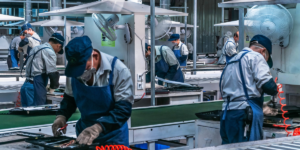May saw the highest expansion in China’s manufacturing sector in almost two years, according to the Caixin/S&P Global Manufacturing PMI, which increased from 51.4 in April to 51.7 in May, above analysts’ forecasts of 51.5. The 50-point cutoff separates contraction from expansion. This impressive performance is the result of increased orders and excellent output, supported by favourable industrial policy.
High Output and Fresh Orders :
China’s manufacturing sector expanded significantly in May as a result of an increase in new orders and production. An important measure of the state of the manufacturing sector, the Caixin/S&P Global Manufacturing PMI, rose to 51.7, the highest level since June 2022.
This gain was higher than the 51.4 from the previous month and more than the 51.5 predicted by analysts. The expansion of the sector is shown by the PMI’s increase above the 50-point threshold.
Comparing Private and Official Surveys :
The Caixin survey revealed strong growth, however it was in opposition to an earlier government poll that indicated a fall in manufacturing activity. This disparity reveals a conflicting picture of the manufacturing environment in China.
Compared to the more general official PMI, the Caixin survey—which tends to focus more on smaller, export-oriented firms—presented a more positive picture.
A rise in both domestic demand and output :
Manufacturing output increased at the quickest rate since June 2022, with the consumer sector seeing particularly strong improvements. Higher new job inflows as a result of rising domestic and international demand drove this expansion.
The survey’s participants mentioned that recent trade shows and deliberate forays into foreign markets helped generate new orders. But the state of the world economy continues to be a problem, slowing the growth of export orders.
Economic Strategies and Market Attitudes :
In order to stabilise the economy, raise domestic demand, and create jobs, senior economist Wang Zhe of Caixin Insight Group underlined the necessity for more robust and consistent measures. The optimistic attitude among producers in May was indicative of growing hopes for both domestic and foreign market demand.
Increasing Input Prices and Workplace Difficulties :
In May, manufacturers had to contend with increased input costs due to rising energy, metal, and plastics prices, which caused input price inflation to reach its highest level since October.
Employment in the industry remained sluggish, with the ninth consecutive month of reduction, despite the strong output and order figures. But the rate of job losses decreased, and some producers of consumer goods even reported a small increase in personnel.

china’s Economic Background :
The expansion of China’s manufacturing sector coincides with more general economic difficulties, such as an ongoing real estate crisis that has undermined consumer and business confidence.
However, there are encouraging hints. In a recent update, the International Monetary Fund (IMF) increased its prediction for China’s economic growth in 2024 from 4.6% to 5%.
Conclusion :
China’s manufacturing industry is resilient and has potential, as demonstrated by the most recent Caixin/S&P Global Manufacturing PMI. The sector grew in May, despite conflicting indications from various surveys and persistent economic difficulties, which highlights the importance of favourable industrial policies and robust domestic and international demand.
Consistent economic policies and initiatives to tackle issues with employment and input costs will be essential in the future to maintain this momentum.

